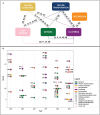Integrated Multi-Omics Analyses in Oncology: A Review of Machine Learning Methods and Tools
- PMID: 32695678
- PMCID: PMC7338582
- DOI: 10.3389/fonc.2020.01030
Integrated Multi-Omics Analyses in Oncology: A Review of Machine Learning Methods and Tools
Abstract
In recent years, high-throughput sequencing technologies provide unprecedented opportunity to depict cancer samples at multiple molecular levels. The integration and analysis of these multi-omics datasets is a crucial and critical step to gain actionable knowledge in a precision medicine framework. This paper explores recent data-driven methodologies that have been developed and applied to respond major challenges of stratified medicine in oncology, including patients' phenotyping, biomarker discovery, and drug repurposing. We systematically retrieved peer-reviewed journals published from 2014 to 2019, select and thoroughly describe the tools presenting the most promising innovations regarding the integration of heterogeneous data, the machine learning methodologies that successfully tackled the complexity of multi-omics data, and the frameworks to deliver actionable results for clinical practice. The review is organized according to the applied methods: Deep learning, Network-based methods, Clustering, Features Extraction, and Transformation, Factorization. We provide an overview of the tools available in each methodological group and underline the relationship among the different categories. Our analysis revealed how multi-omics datasets could be exploited to drive precision oncology, but also current limitations in the development of multi-omics data integration.
Keywords: cancer; machine learning; multi-omics; oncology; systematic review; tools.
Copyright © 2020 Nicora, Vitali, Dagliati, Geifman and Bellazzi.
Figures

References
Publication types
Grants and funding
LinkOut - more resources
Full Text Sources
Medical

